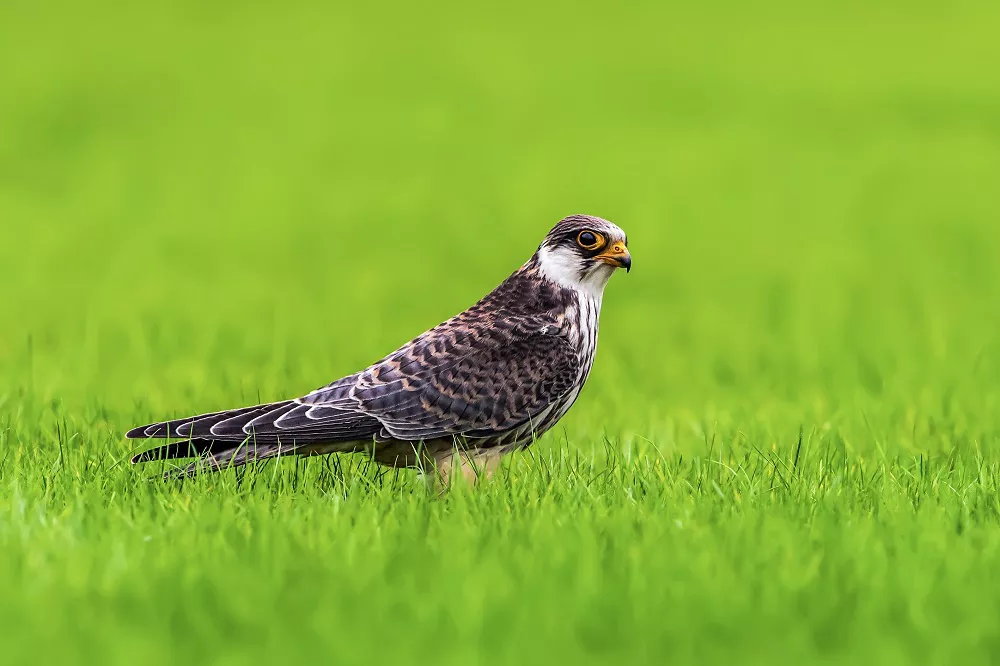The Amur Falcon (Falco amurensis) and Red-Footed Falcon (Falco vespertinus) are two species of small falcons that belong to the same family, Falconidae. These birds are known for their impressive hunting skills and unique physical characteristics. However, despite their similarities, they have notable differences in terms of appearance, habitat, behavior, and migration patterns. This article aims to provide an in-depth analysis of these two species and highlight their distinctive features.
Physical Characteristics
The Amur Falcon is a small-sized bird that measures about 25-30 cm in length and has a wingspan of approximately 60 cm. The males have a striking appearance during the breeding season, with a dark bluish-gray head and back, a reddish-brown chest, and a white belly. The females, on the other hand, have a brownish-grey coloration throughout the body.
The Red-Footed Falcon is slightly larger than the Amur Falcon, with a length of 29-35 cm and a wingspan of 75-85 cm. The males have a blue-grey head and upperparts, a rufous chest, and a white belly. The females, however, have a brownish-grey coloration similar to the female Amur Falcon but with a more prominent mustache stripe.
One of the most significant differences between the two species is the red feet of the Red-Footed Falcon, which is absent in the Amur Falcon.
Habitat and Distribution
The Amur falcon breeds in eastern Asia, particularly in Russia, China, and Mongolia. Migrate to southern Africa during the non-breeding season. During migration, they pass through India and Southeast Asia where they roost in large numbers.
The Red-Footed Falcon breeds in Europe and Asia and migrates to southern Africa and Madagascar. They also pass through the Middle East, where they form large flocks during migration. Both species prefer open landscapes such as grasslands, savannas, and agricultural areas with scattered trees for perching and nesting.
Behavior and Diet
The Amur Falcon is an aerial hunter that feeds mainly on insects, especially termites, dragonflies, and locusts. During the breeding season, they also prey on small birds, such as swallows and martins.
The Red-Footed Falcon, on the other hand, feeds on insects such as grasshoppers, beetles, and butterflies, but also consumes small birds, lizards, and rodents. Both species are diurnal hunters, meaning they hunt during the day, and use their excellent eyesight to spot their prey from high altitudes.
However, the hunting techniques of the two species differ slightly. While the Amur Falcon hunts by stooping or diving towards its prey, the Red-Footed Falcon does more hovering and tail-chasing before attacking its prey.
Migration Patterns
Both species undertake extensive migrations covering thousands of kilometers each year. The Amur Falcon has one of the longest migrations of any bird in the world, traveling up to 20,000 km from Siberia to southern Africa. They migrate in huge flocks and roost communally in large trees at night. They typically arrive in India in September and stay until November before continuing their journey south.
The Red-Footed Falcon also migrates in flocks and travels over long distances, covering up to 7,000 km each way. They typically arrive in South Africa in October and return to their breeding grounds in April.
Conclusion
In conclusion, the Amur Falcon and Red-Footed Falcon are two fascinating species of small falcons that share some similarities but have some notable differences in terms of physical characteristics, habitat, behavior, and migration patterns. While both are excellent hunters with impressive flying abilities, the Red-Footed Falcon stands out for its distinctive red feet and larger size. Understanding these differences is essential for birdwatchers, conservationists, and researchers to better appreciate and protect these amazing birds.


 Facebook
Facebook  Instagram
Instagram  Youtube
Youtube 